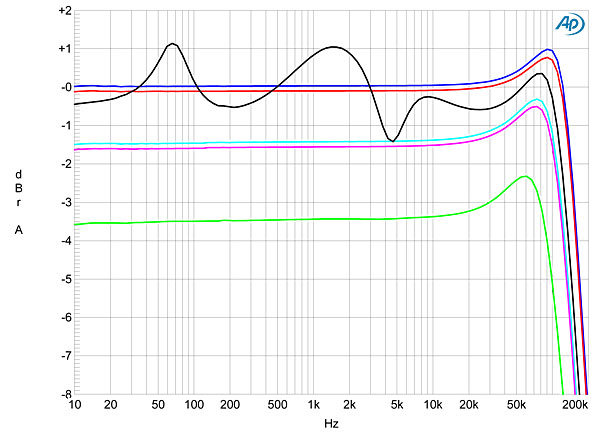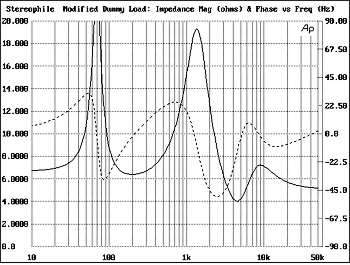Fretbuzz
pfm Member
Remembered coming across this before getting my first Croft:
Reflecting back on Stereophile’s Croft Integrated review – Audioflair
Reflecting back on Stereophile’s Croft Integrated review – Audioflair
Remembered coming across this before getting my first Croft:
Reflecting back on Stereophile’s Croft Integrated review – Audioflair
Measurements tell about electrical performance/compatibility, they are factual.
Raving tells about personal preference, it's a matter of personal opinion.
If you look at the frequency response plot you will see that when the amplifier is driving a speaker load the response is all over the place (black trace).
Different speakers will produce a different load, to the all-over-the-place will vary from speaker to speaker.

As you can see, the combined response of the amplifier/speaker closely mimics the speaker load – peaks and dips at the exact same frequencies (below).

Oh and the mention of Audioflair earlier - this is where I sought my advice an ultimately purchased the Croft from - Adrian is really helpful from that perspective.
I have no idea how that’s a reply to me. I think we all know that listening is about personal preference. I simply stated who did what at Stereophile as it relates to the amp.Measurements tell about electrical performance/compatibility, they are factual.
Raving tells about personal preference, it's a matter of personal opinion.
If you look at the frequency response plot you will see that when the amplifier is driving a speaker load the response is all over the place (black trace).
Different speakers will produce a different load, to the all-over-the-place will vary from speaker to speaker.

As you can see, the combined response of the amplifier/speaker closely mimics the speaker load – peaks and dips at the exact same frequencies (below).

Strange design but the low key appearance has its own appeal.
I couldn't give a **** about a ruler-flat frequency response because that tells you bugger all about how a component reproduces MUSIC.
Measurements tell about electrical performance/compatibility, they are factual.
Raving tells about personal preference, it's a matter of personal opinion.
If you look at the frequency response plot you will see that when the amplifier is driving a speaker load the response is all over the place (black trace).
Different speakers will produce a different load, to the all-over-the-place will vary from speaker to speaker.

Of course it does. Maybe not to you and many others but it tells about the balance between different frequencies/notes.
Would you buy a TV set which reproduced the sky with a green colour cast and yellow-tinted pure whites?
I know accuracy is easier to see than to hear and some degree of deviation from flat/accurate is to be expected but with the Croft, a Prima Luna or a Leben that deviation can be acceptable to massive depending the speakers they’re connected to.
I understand that massive deviation is likely to please some people, to sound “musical” to them, but I find it useful to warn that this may be the case.
no matter your preference the Croft will be affected by the load it’s driving and it will vary a lot more than it does with most amplifiers.
But a loudspeaker is not a constant load. It is varying all the time, anywhere from 2ohms to 60 ohms in some cases, depending on the frequency and the speaker. The variance in the audio range above is around +/-1dB, volume controls vary up to +/- 2dB, and seeing as the human hearing can just about detect 1dB, you will probably never hear or notice this variance. It just goes to prove that although measurements are valid, they need to be put into prospective.
Music and sounds - two very different things. Use the ear-brain to measure the former, lab equipment the latter.
Music is an event in time, so your analogy with TV image quality is irrelevant.
It is precisely the variable load across the audio band that causes issues with amplifiers like the Croft or with SETs.
Studies show that we are able to hear variations as low as 0.2dB depending on the frequency in question and possibly the listener’s training/capabilities. A 2dB difference is more noticeable than a change of cables.
And what issues are those?
Whatever studies show, it is recognised in the audio industry that the smallest perceived change people can hear is 1dB. The standard frequency range for audio is 20-20kHz +/-3dB. A man of approximately 50-60 years old will not be able to hear above 12KHz-13KHz. As I said previously, Prospective!
+/~ 3dB was the goal for speakers at the end of the last century.
I’ve written about the issues of amps having high output impedance earlier in the thread.
